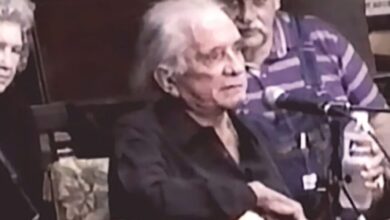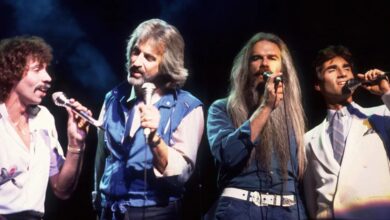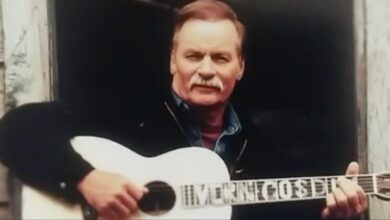The Hollies’ “Bus Stop” Sparks a British Invasion Evolution and Defines Pop Precision in 1966
When “Bus Stop” hit the airwaves in 1966, it didn’t just become a hit—it became a cornerstone of the British Invasion’s second wave. The Hollies, already known for their tight harmonies and infectious melodies, took a leap with this song, capturing both the American and UK charts with a track that felt effortlessly modern, yet timeless. Written by the young and prolific Graham Gouldman, “Bus Stop” climbed to No. 5 on the Billboard Hot 100 and No. 5 in the UK Singles Chart, becoming The Hollies’ breakthrough moment in the United States. The single’s sharp narrative and emotional restraint set it apart from the era’s more psychedelic or bluesy contemporaries, carving a unique niche in 60s pop rock.
Formed in Manchester in 1962, The Hollies were part of the vibrant British beat scene that exploded alongside The Beatles and The Rolling Stones. Known for their bright, three-part vocal harmonies and jangly guitar work, they were led by Allan Clarke and Graham Nash—friends since childhood—whose voices created an unmistakable blend. While they initially built their career on covers and singles that mirrored the Merseybeat trend, it was clear from the beginning that The Hollies had a cleaner, more melodic sensibility. Their consistency in the UK charts was unmatched in the mid-60s, but international acclaim remained just out of reach—until “Bus Stop” rewrote their trajectory.
The origin of “Bus Stop” traces back to songwriter Graham Gouldman, then a teenager already responsible for several hits by The Yardbirds and Herman’s Hermits. Gouldman wrote the song while working at a men’s clothing shop, sketching lyrics during slow hours. Inspired by the mundane routines of city life, he imagined a romantic story unfolding at a literal bus stop—two strangers meeting each day under a shared umbrella. The genius of the song lies in its simplicity: a tale of everyday life transformed into a poignant love story, echoing the narrative clarity of Beatles songs like “Eleanor Rigby,” but with its own twist of domestic romance and destiny.
The recording of “Bus Stop” was as polished as the song itself. Produced by Ron Richards at EMI’s Abbey Road Studios, the track featured Tony Hicks’ distinctive 12-string guitar intro—crisp and chiming, a sound that immediately hooked listeners. Allan Clarke’s lead vocal, flanked by Graham Nash’s soaring harmonies, created a shimmering, unified vocal sound that had become The Hollies’ signature. The tightness of the rhythm section and the precise pop production gave the track a mechanical perfection, mirroring the orderly setting of a bus stop, yet brimming with human warmth.
Upon release, the single met with immediate acclaim. In the UK, it solidified The Hollies’ reputation as hitmakers, but it was its transatlantic performance that marked a turning point. “Bus Stop” was their first major U.S. hit, earning them a coveted spot on American radio during a time when British acts still had to fight for airtime against domestic heavyweights. Its chart longevity and appeal across age groups made it a standout not just commercially, but culturally, placing The Hollies firmly among the elite British bands with global resonance.
More than a chart hit, “Bus Stop” subtly shifted the expectations of pop songwriting. While many British Invasion bands leaned heavily into blues riffs or psychedelic experimentation, The Hollies kept things lean and articulate. The song’s clean lines and universal theme allowed it to cross class and cultural divides, making it a staple on jukeboxes, radio stations, and teenage record players alike. It elevated narrative-driven songwriting in pop and showed that a song didn’t have to be abstract or rebellious to feel profound.
The success of “Bus Stop” opened doors that had previously remained closed for The Hollies. They launched a successful American tour and began recording more original material, boosting their confidence as songwriters and performers. While Graham Nash would eventually depart to pursue more introspective and experimental work with Crosby, Stills & Nash, the momentum created by “Bus Stop” established the band as a transatlantic force, no longer confined to UK popularity.
“Bus Stop” also left its mark on the evolving pop-rock genre. Its smart fusion of folk-style lyricism with pop structure anticipated the rise of singer-songwriters in the early 70s. It also influenced bands like The Byrds and The Turtles, who adopted a similar balance of melodic clarity and subtle storytelling. Its lyrical straightforwardness paired with lush instrumentation proved that pop could be both emotionally rich and commercially viable.
Over the years, “Bus Stop” has been covered by artists ranging from Herman’s Hermits to Suzi Quatro, each offering their own spin on its conversational charm. But none have matched the magic of the original, where everything from the vocal delivery to the guitar phrasing captured a specific moment in time with lasting resonance. The song’s relatability made it a favorite for reinterpretation, yet its perfection made it nearly untouchable.
At the time of the song’s release, The Hollies were also navigating personal transitions. Graham Nash was beginning to feel artistically restless, yearning for more political and psychedelic expression—something that would eventually lead to his departure. But within “Bus Stop,” there remains the sound of harmony—both musically and emotionally—during a golden moment when everything aligned just right.
Decades later, “Bus Stop” continues to appear on best-of lists and receives steady radio play, a testament to its timeless nature. Its charm lies in the way it captures a mundane setting and elevates it into something poetic, a love story set against the backdrop of everyday life. In an age where pop often leaned toward the fantastical or rebellious, The Hollies reminded listeners of the beauty in the ordinary.
It’s not an overstatement to say that “Bus Stop” changed how pop songs could be structured and received. With its economy of words, crisp arrangement, and emotional accessibility, it laid the groundwork for a more narrative-driven approach in mainstream music. It also helped transition pop from the raw energy of early rock and roll to a more refined, studio-polished craft.
The Hollies were later inducted into the Rock and Roll Hall of Fame in 2010, a long-overdue recognition of their role in shaping 60s pop and beyond. Though “Bus Stop” wasn’t their only hit, it was the song that altered their legacy, turning a successful UK act into a global name. Its enduring appeal helped secure their place in music history.
Ultimately, “Bus Stop” remains one of the 1960s’ most beloved singles—not because it was flashy or revolutionary, but because it told a story we all understood. In just over two and a half minutes, The Hollies managed to distill the uncertainty and charm of human connection into song form. In doing so, they created not just a hit, but a small, perfect piece of pop history.



